Urban Edge Staff Meeting
09/13/2021
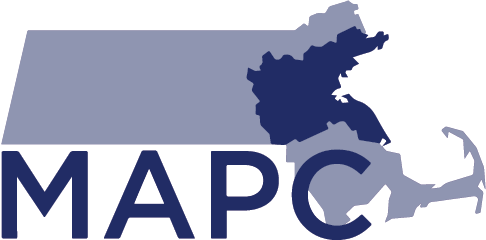
Agenda
Welcome and Meeting Goals
About MAPC and Project Process
Digital Access in Columbus Ave Corridor
Discussion-Breakout rooms

Please post questions and comments in the chat!
Next Steps
Meeting Goals

Understand Urban Edge programs and how they interface with technology
Identify Digital Equity and Access strategies for Urban Edge constituents
Discuss Community Engagement strategy
Introduce MAPC and Columbus Corridor Project
-
Housing
-
Transportation
-
Climate Resilience and Clean Energy
-
Economic Development
-
Land Use
-
Municipal Government
-
Policy
-
Digital Access


Metropolitan Area Planning Council



- School / Education
- Work
- Healthcare
- Workforce Training
- Access to Social Assistance and Resources
- Economic Development
Pandemic & Beyond
Everett, Chelsea,Revere
The Development of an Municipal Digital Access and Equity Plan will:

Advise Capital Investment
Inform Policy Decisions
Identify Program Needs
Phases of Work

- Evaluation of Current Internet Providers and Levels of Service
- Analysis of Community Access to Device and Internet
Phase 1A: Existing Conditions
Phase 1B: Community Needs Assessment
- Identification of Population Specific Challenges and Needs via Survey
- Focus Group(s) and Key Stakeholder Interviews with Community Members
-
Review of Existing Infrastructure and Assets Along Columbus Ave
-
Assessment of Potential Technology Interventions and Programs
Phase 2: Infrastructure and Technology Evaluation
- Development of an Operational Framework that Urban Edge can use to Implement a Tech Solution, PLUS Programs for Skills Development and Community Ownership
Phase 3: Digital Operation Framework
In June the U.S. Department of Commerce’s National Telecommunications and Information Administration (NTIA) released a map that displays key indicators of broadband needs across the country.
Columbus Ave Corridor stood out
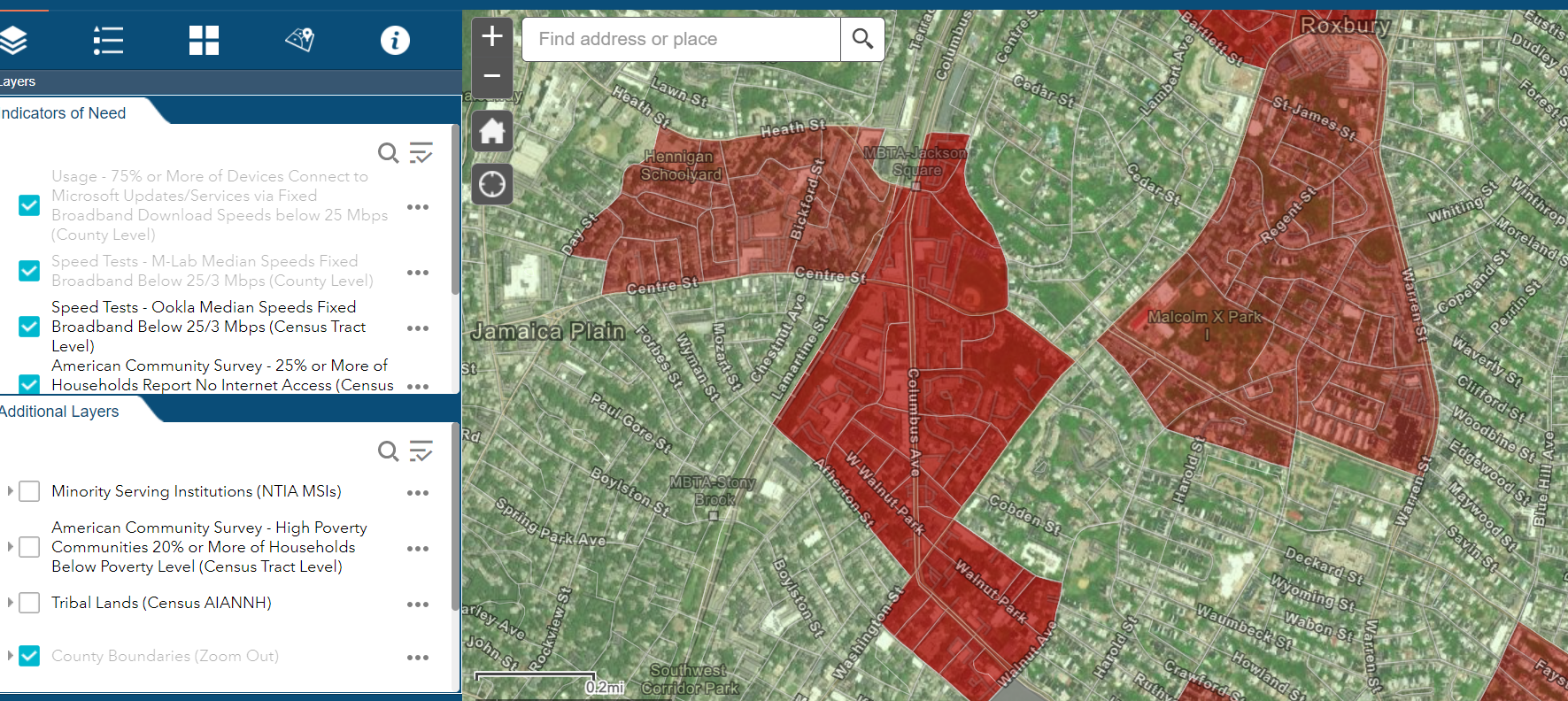
NTIA Map
According to this Census data 39% of “Columbus Ave Corridor” households do not have access to the internet.
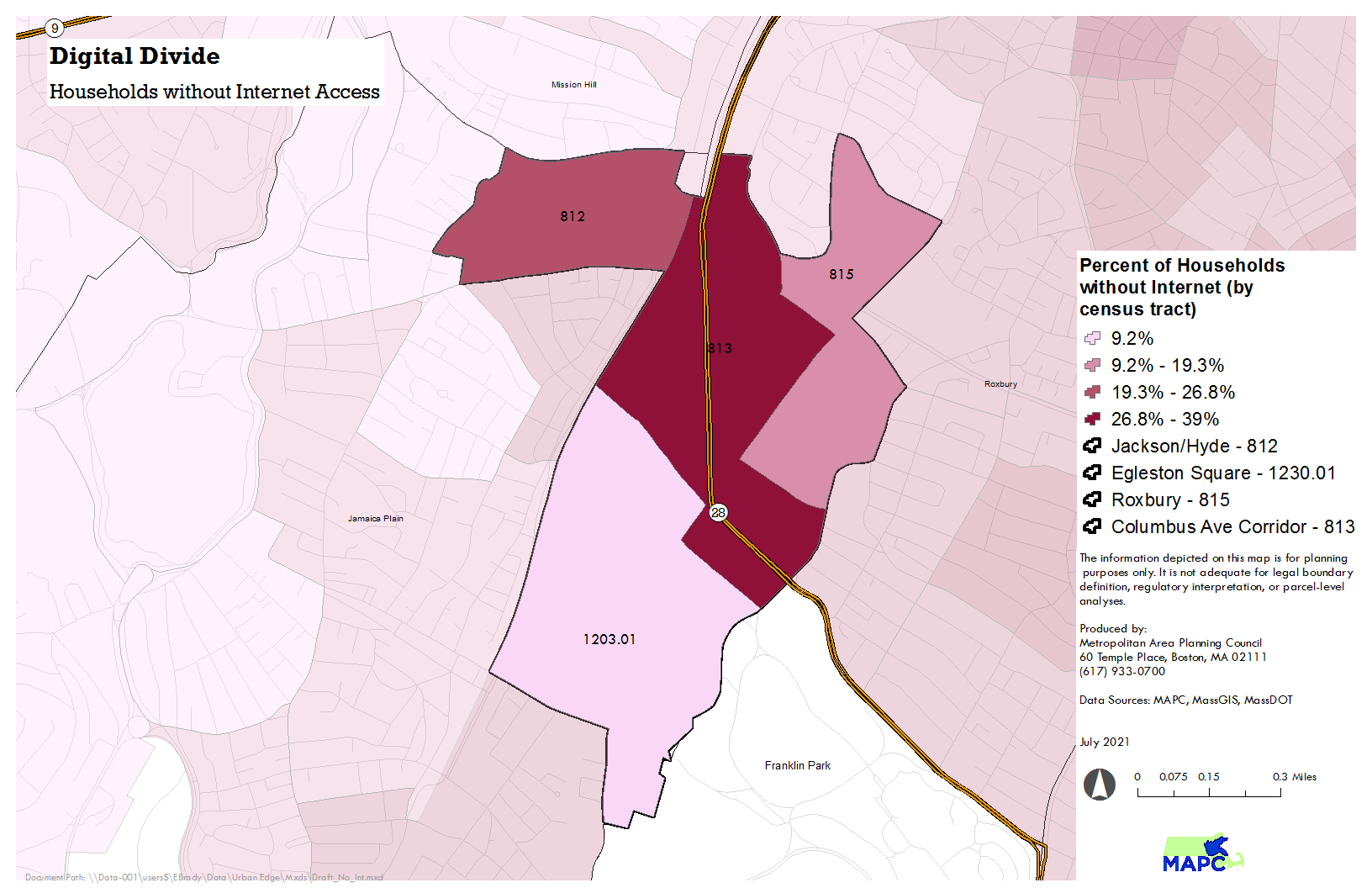
Households Without Internet

Households Without a Computer
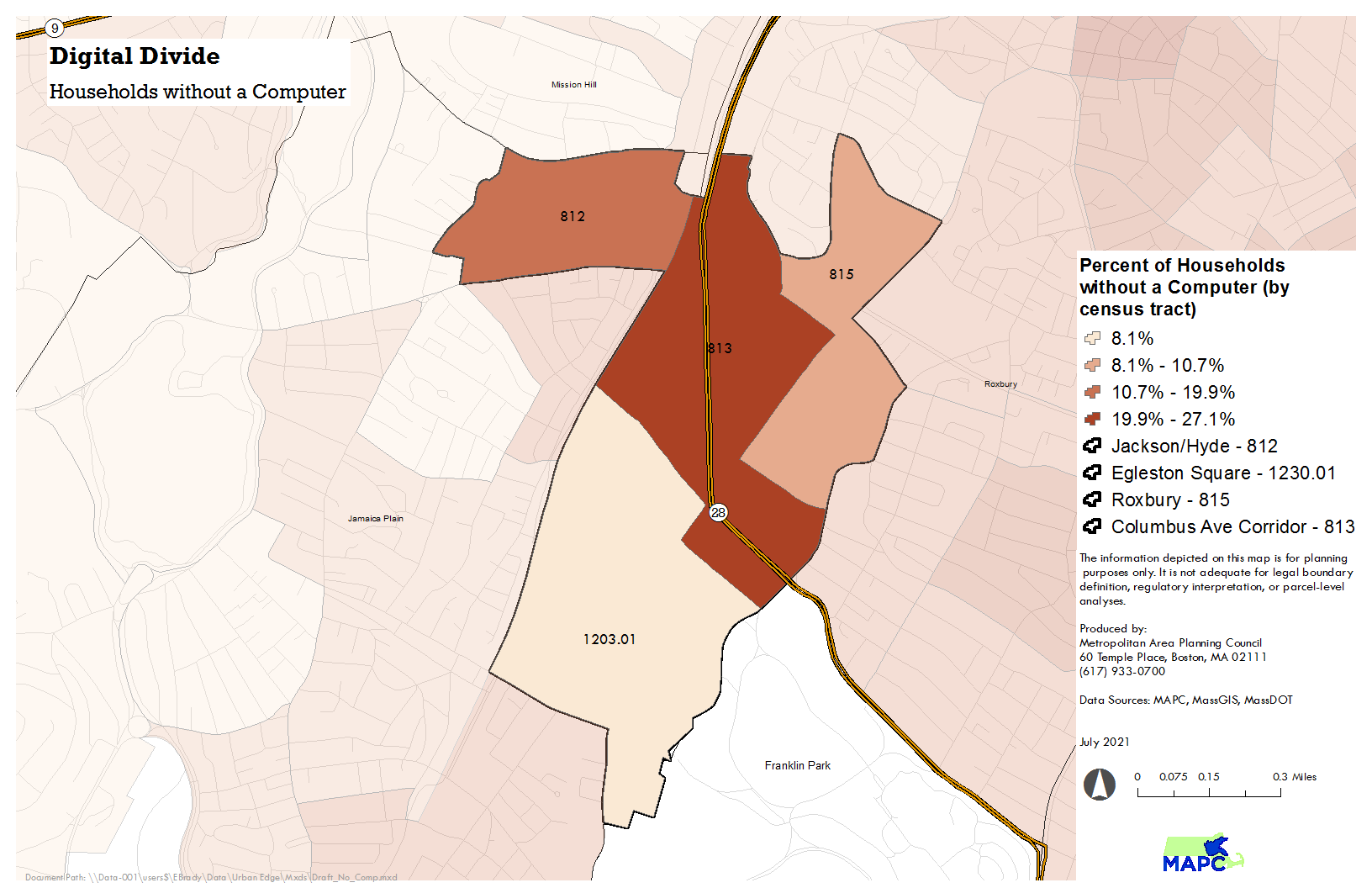
According to this Census data 27.1% of “Columbus Ave Corridor” households do not have a computer.

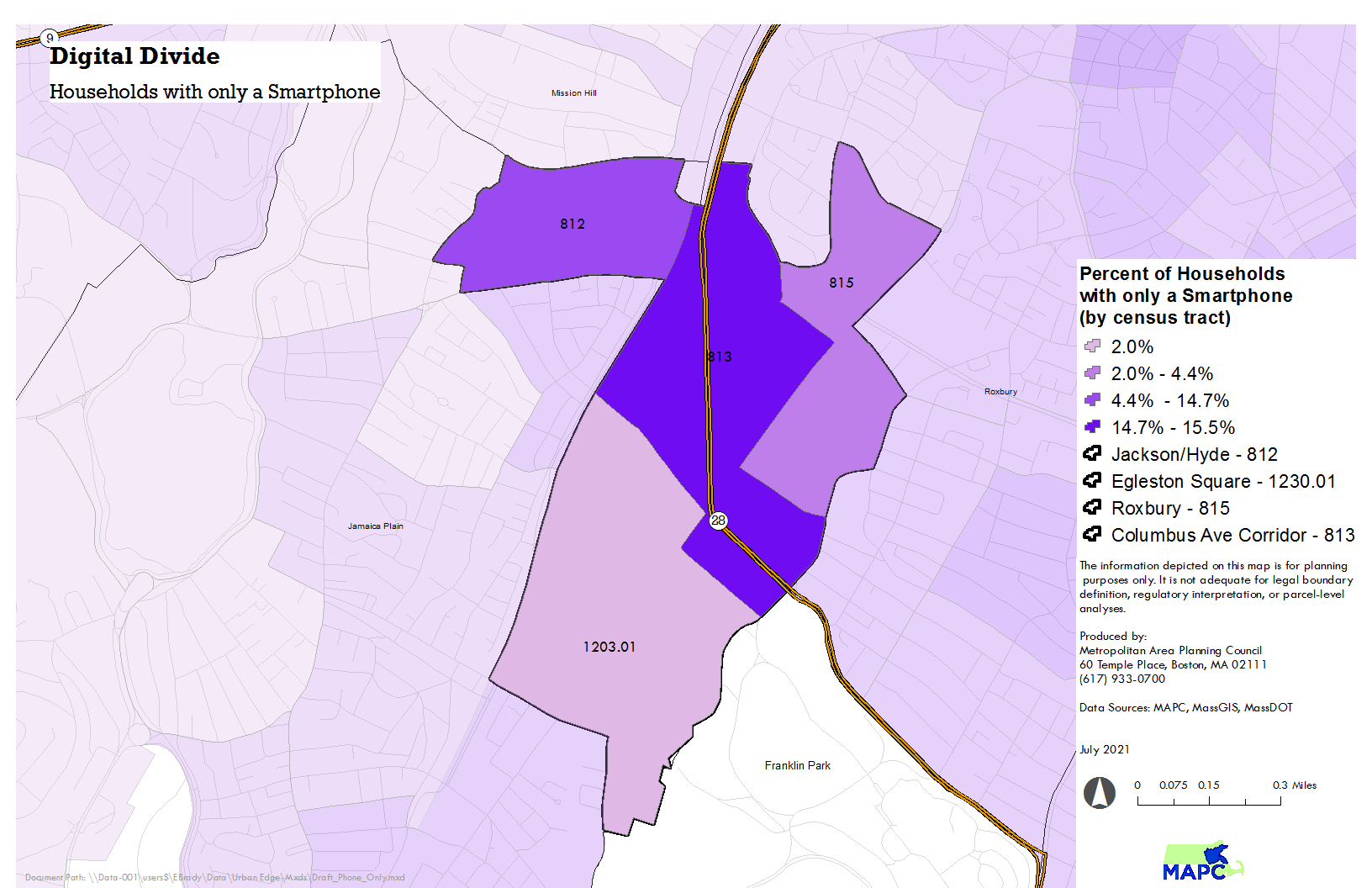
According to this Census data 15.5% of “Columbus Ave Corridor” households are soley reliant on a smartphone for internet access.
Households With Only a Smart Phone


Three Determining Factors of Digital Access



Connection
Adequate Device
Literacy
Fast
Affordable
Router
Personal Computer /Laptop
Use of Technology
Ensuring functioning equipment
Evaluating quality of information and privacy risks

Digital Justice Principles
Digital justice provides multiple layers of communications infrastructure in order to ensure that every member of the community has access to lifesaving emergency information.
Digital justice ensures that all members of our community have equal access to media and technology, as producers as well as consumers.
Digital justice values all different languages, dialects and forms of communication.
Source: Allied Media, Teaching Community Technology Handbook
Breakout Groups

Current state of Urban Edge technology use and
Digital Access in the community
Brainstorm ways to improve Digital Access and opportunity
Discuss Community Engagement strategy

Next Steps

Develop Outreach Strategy with Urban Edge Community Engagement Team
Facilitate meetings with Stakeholder Groups
Begin Community Needs Assessment
Community
-
Pam Walker Dimock Bragdon resident and community leader
-
Denise Thompson, Jackson Commons resident and community leader
-
Carol Miranda, Tree of Life, Executive Director
-
Marchelle Jacques-Yarde, Union Capital Boston (UCB), Director of Operations & Partnerships.
-
Durrell Harris, Urban Edge, Associate Director of Community Engagement
-
Alia Pacombe, Urban Edge, Director of Community Engagement
Stakeholder Groups
Workforce Development
-
Salvatore Pina, Roxbury Community College (RCC), Director of Workforce Development
-
Leslie Wood, Roxbury Community College
-
Justin Petty Director, RCC Broadcast Media Technology
-
Amy Nishman, Jewish Vocational Services (JVS), Senior Vice President of Strategy
-
Tech Goes Home
-
Timothy Smith
-
Youth Services of Boston

Affordable Housing
-
Anne Vinick, The Community Builders, Director of Community Life New England
-
Laura Martin The Community Builders (TCB) Project Manager
-
Domenic Butler WinnCompanies, Divisional Vice President
-
Dimmock Health Center
-
Warren Williams, E.D,. Three Squares Main Streets
-
Denise Delgado Egleston Square Main Streets, Executive Director
-
Susan O’Connor BNN
-
Glen Williams BNN
-
John Fitterer MA Association of Community Development Corporations (MACDC), Dir. of Operations
-
Library
-
JPNDC
Neighborhood Allies
Stakeholder Groups

-
Mike Lynch City of Boston, Director of Broadband and Cable
-
Lydia Argo Boston Housing Authority
-
Boston Public Schools
Municipal
Stakeholder Groups

Thank you!
